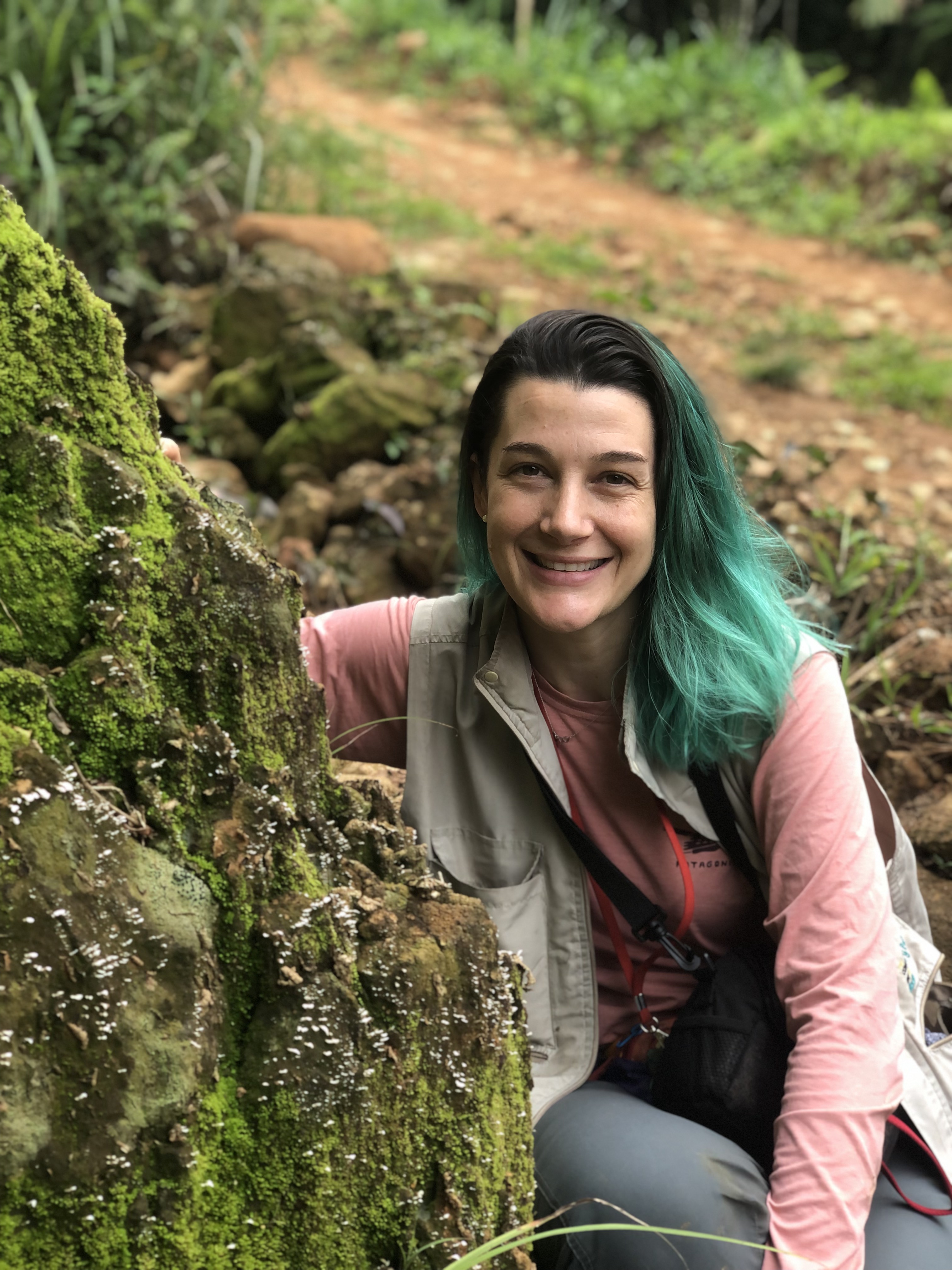NATIONAL MUSEUM OF NATURAL HISTORY
Meet the Smithsonian Fellow Alumni Helping to Save the Planet
This Earth Day, learn about early-career researchers who are tackling issues from green technology to lichen biodiversity and coral rehabilitation
:focal(2592x1950:2593x1951)/https://tf-cmsv2-smithsonianmag-media.s3.amazonaws.com/filer_public/63/ce/63ce1c61-b5a7-446f-b00f-4162f79719d0/lichen1-1-24-23-10stack-edit.jpg)
In celebration of Earth Day, embark on a global journey with alumni of the National Museum of Natural History’s Peter Buck Postdoctoral Fellowship program. From remote island coasts to magma currents deep below Earth’s surface, these researchers’ passion for preserving biodiversity has taken them to the farthest corners of the planet.
Now on the frontlines of conservation, these former fellows are addressing urgent environmental challenges and educating the next generation of scientists. The researchers recently presented at the museum’s “Life on a Sustainable Planet: Exploring and Understanding Our Natural World” science symposium, highlighting their scientific journeys studying everything from rare minerals used in green technology to biodiversity in endangered coral and lichen populations.
Saving Smothered Coral Reefs
/https://tf-cmsv2-smithsonianmag-media.s3.amazonaws.com/filer_public/75/34/7534bf55-aaf9-45b5-82a4-aa4867224b3d/reefflat.jpg)
Around the world, coral reef ecosystems that were once buzzing with the sounds of chattering parrotfish and snapping pistol shrimp are falling quiet. Too quiet. Decades of human activity is causing one of the most diverse marine ecosystems to wither away, and researchers are determined to intervene before it’s too late.
When marine biologist and bioinformatics scientist Bastian Bentlage first moved to the tropical island of Guam in 2016, immense marine heat waves wiped out nearly 80% of local coral reef ecosystems.
“You can hear when a coral reef is dying,” Bentlage said. “You can close your eyes in the ocean and hear that something isn't right, because you don't hear anything.”
As an associate professor of bioinformatics at the University of Guam, Bentlage has spent the last eight years leading efforts to increase the research capacity on the remote island. His team is now studying the impact of sedimentation on the symbiotic algae and bacteria that are vital to the health and survival of coral reefs.
Coastal development and poor land management practices are a major cause of erosion and terrestrial runoff in island ecosystems, producing loose soil that is washed into rivers leading to the ocean. These sediments eventually settle on the ocean floor, smothering near-shore coral reefs and their symbiotic organisms.
/https://tf-cmsv2-smithsonianmag-media.s3.amazonaws.com/filer_public/b1/f0/b1f06c4f-d7e8-4f34-88e6-45cdcf099c0b/soilsampling.jpg)
Using an array of methods including tissue sampling, genetic sequencing and field experiments, Bentlage took a closer look at the biological impact of these sediments on Guam’s coral reefs. The research revealed numerous genetic and physiological responses that coral symbionts employ when dealing with sedimentation stress, illustrating the direct connection between human activity on land and the effects on the surrounding marine ecosystems.
While completing his Buck fellowship in the museum’s Department of Invertebrate Zoology, Bentlage built a valuable skillset in genetic and molecular research. In Guam, sequencing the full genomes, or genetic code, of coral and their symbionts has allowed Bentlage to map their diversity across the island’s coral reefs. This data provides critical information for coral restoration groups, supporting the development of new approaches to manage and mitigate the impacts of human activity and climate change.
Bentlage has also become passionate about educating local students on coral biodiversity, hoping they will eventually take over as the future custodians of the island ecosystem.
“I never saw myself as an educator, but I have found it to be the most amazing part of my job,” Bentlage said. “The research is great, but I am incredibly humbled when I put the work in the hands of my students so they can go off and make their own impact on the world.”
Tracing Rare Minerals Essential for the Green Technology Revolution
/https://tf-cmsv2-smithsonianmag-media.s3.amazonaws.com/filer_public/95/c1/95c13364-2cf7-4de7-b0ea-046fbc25ba71/screen_shot_2024-04-22_at_110930_am.png)
While most of us think of Earth's crust as a static, solid mass beneath our feet, it is actually a dynamic entity, constantly in motion with magma currents coursing through its depths. And flowing through these currents are traces of the rare Earth elements that are vital to the future of sustainable, green technology.
As an assistant professor at the New Mexico Institute of Mining and Technology, Laura Waters has spent her career studying deep geologic history, focusing on how Earth formed its continents. However, she was immediately intrigued when researcher Dr. Alexander Gysi asked her to use these same experimental methods and contribute to his project centered around the mineral resources required to develop green technology.
Rare Earth elements are a group of transition metals including lanthanum, cerium and neodymium, all of which are essential to the development of batteries, catalytic converters, magnets and lasers that are foundational to green technology. But these critical elements are difficult to find, which slows the production of sustainable energy tools.
“Our main goal is to improve models that are used to predict where these different rare elements are concentrated in the Earth, so that mining geologists can efficiently extract them for use in green technology, like electric vehicles,” Waters said.
Waters conducted her experiments using a large, high-pressure instrument called a cold seal pressure vessel. During her time as a Buck fellow, Waters learned foundational skills from NMNH geologists Ben Andrews and Tim Gooding about how to build her own experimental apparatus from the ground up. The instrument she constructed in her lab employs a series of furnaces to simulate magmatic conditions in the Earth’s crust, and test how different critical elements will react in these extreme settings.
/https://tf-cmsv2-smithsonianmag-media.s3.amazonaws.com/filer_public/76/a2/76a25a4c-6096-4c7c-a979-2268c6872559/screen_shot_2024-04-17_at_40939_pm.png)
After calculating how much each rare Earth mineral is predicted to dissolve at various temperatures, the research team will compile their findings into a database of thermodynamic parameters, which will be used to recalibrate modeling software. In the future, this model will be used in the field to forecast where rare Earth elements are moving through the crust.
“We hope that this database will allow researchers and workers in the field to mine rare elements more precisely,” Waters said. “Ultimately this should minimize the impact on the planet, while also creating sustainable, green technology.”
Preserving the Past and Exploring the Future with Lichens in Museum Collections

Lichens are present almost everywhere you look. With over 20,000 species known to science, these small symbiotic systems of fungi and algae have colonized most terrestrial ecosystems on Earth. But despite their omnipresent status, little is known about these ecosystem engineers, and there are likely hundreds of thousands of species that have yet to be discovered and described.
This is where Manuela Dal Forno’s research comes in. As a lichenologist at the Botanical Research Institute of Texas, Dal Forno has dedicated her career to studying the diversity and evolution of lichens from around the world.
Traveling throughout Latin America and working with collaborators, Dal Forno has collected lichens from many countries that were underrepresented in lichen research. However, most of the specimens that Dal Forno studied were sitting on the shelves of historic botanical collections like the Smithsonian’s US National Herbarium.
During her recent Buck fellowship at the museum, Dal Forno delved into the Smithsonian’s collection of lichens, taking tiny samples of over 400 specimens for DNA extraction and sequencing. She also used the sample labels written by the original collecting scientists to learn more about the ecological traits of the lichens, answering questions about the environment where each species was found.
/https://tf-cmsv2-smithsonianmag-media.s3.amazonaws.com/filer_public/5e/57/5e5786ff-3c21-48d3-a7b0-21330528b657/lichen1-1-22-21-8stack.jpg)
Dal Forno focuses on a lichen group that had previously been comprised of just a few species. But utilizing integrative studies, she found that this group contains hundreds of species that were completely new to science.
“One group of 275 specimens kept in the National Herbarium were all categorized as a single lichen species,” Dal Forno said. “After we sequenced their genes and reassessed their characteristics, we found that there were over 75 different species represented there, not just one.”
Improved understanding of lichen taxonomic classifications and evolutionary patterns will offer a roadmap to guide future conservation and collection efforts. Lichens play important roles in every ecosystem in the world, fixing nitrogen to make it usable for plants, acting as an essential food source for countless species and colonizing extreme environments to make them livable for other organisms.
In the face of climate change and human activity, it has become more important than ever to understand lichen diversity and preserve their genetics for future generations of scientists.
“Lichen habitats are disappearing,” Dal Forno said. “But these historical collections will help us get boots on the ground to collect specimens in areas that are most in need of our efforts.”
How do Animals Respond to a Changing Planet?
/https://tf-cmsv2-smithsonianmag-media.s3.amazonaws.com/filer_public/90/38/9038ed63-f9b1-44c5-8a86-d05d708f6906/dsc_2352.jpg)
When faced with periods of environmental turmoil, species have essentially three options: go extinct, move or adapt. While past research has often focused on large extinction events and changes in the resulting communities, less is known about how species can persist and survive through times of global change.
Do prey get larger to avoid predation? And how do predators respond to changing prey populations? How do mammals react to temperature changes? These are all questions that Meghan Balk, a postdoctoral fellow in Evolution and Paleobiology at the Naturhistorisk Museum in Oslo, Norway, has been asking throughout her career.
Using museum collections and AI-driven techniques to extract trait data from fossil and modern specimens, Balk explores how ecological interactions may drive evolution within species lineages and across communities.
Referencing the large evolutionary patterns delineated by past researchers, Balk is interested in testing whether these trends can be applied to smaller scale adaptations seen at the species level.
For example, a 2012 study found that mammal species decrease in size ten times faster than they increase. To test if this was true on a micro-evolutionary scale, Balk looked at the fossil record of packrats, going back over 30,000 years. While the overall pattern did not translate to this small species, Balk did find that changes in body size have allowed packrats to handle a myriad of temperature ranges throughout their history.
/https://tf-cmsv2-smithsonianmag-media.s3.amazonaws.com/filer_public/2d/6e/2d6efc79-d3fb-4285-a322-01b0a1d83c4e/fossil_dig_nm.jpg)
In a modern era of rapid climate and environmental change, it is important to understand the processes that allow species to react and persist. Balk’s work also sheds light on how species interact with one another. During her Buck fellowship, Balk cataloged and digitized hundreds of specimens of shark-bitten bones to expand upon her work investigating phenotypic change of animals in response to uncertain environmental conditions and prey species.
When she’s not analyzing fossil collections, Balk is passionate about educating the next generation of scientists about her work, hoping that they will build upon her research and apply it to the fields of biodiversity, conservation and sustainability.
“Human impacts on the environment, such as over-fishing and habitat destruction, restrict how species can respond in periods of global turmoil,” Balk said. “However, I hope my research reveals how resilient species are, and the ways in which they have coped with environmental change in the past.”
Related Stories
What Mummified Shrews and Giant Hornets Reveal About Biodiversity
This Earth Day, the Planet’s Health is Your Health
NMNH in Review: Top Discoveries by Museum Scientists in 2023
Why Fishes are the Catch of the Day for Climate Research
Smithsonian Scientists Unearth Signs of an Ancient Climate Calamity Buried Beneath the Seafloor

